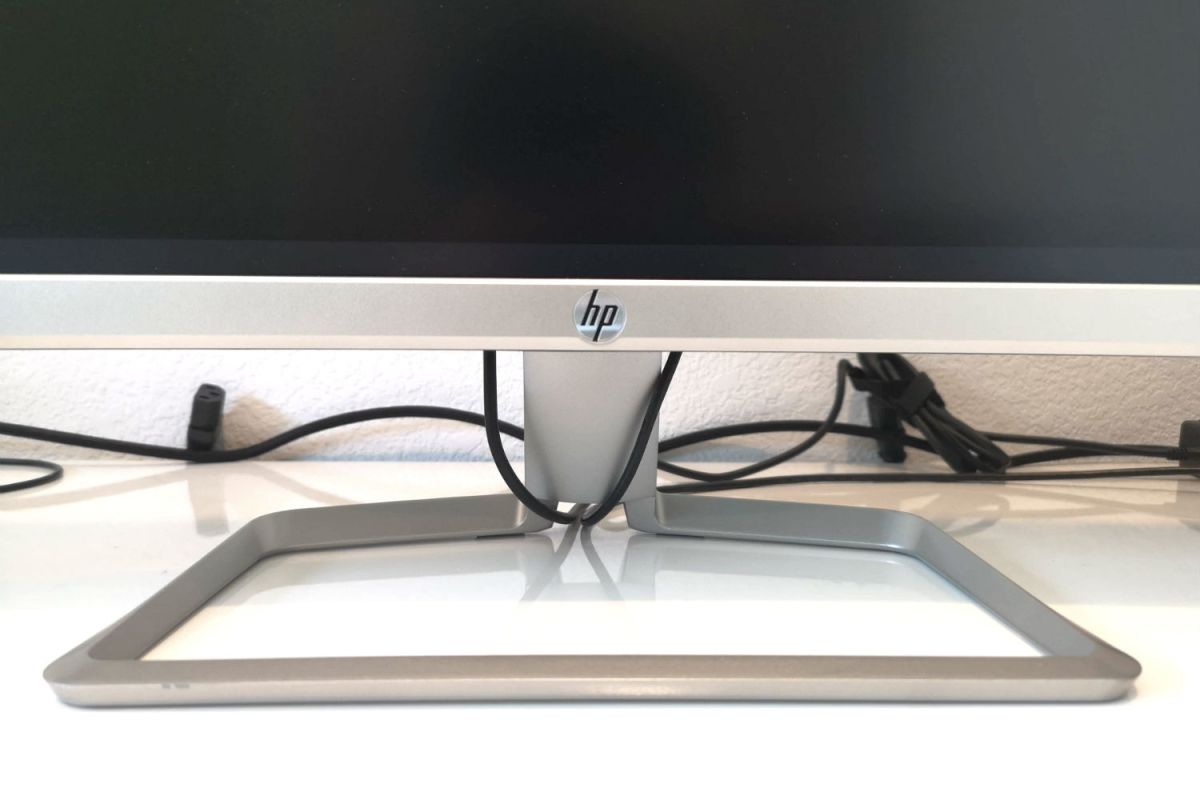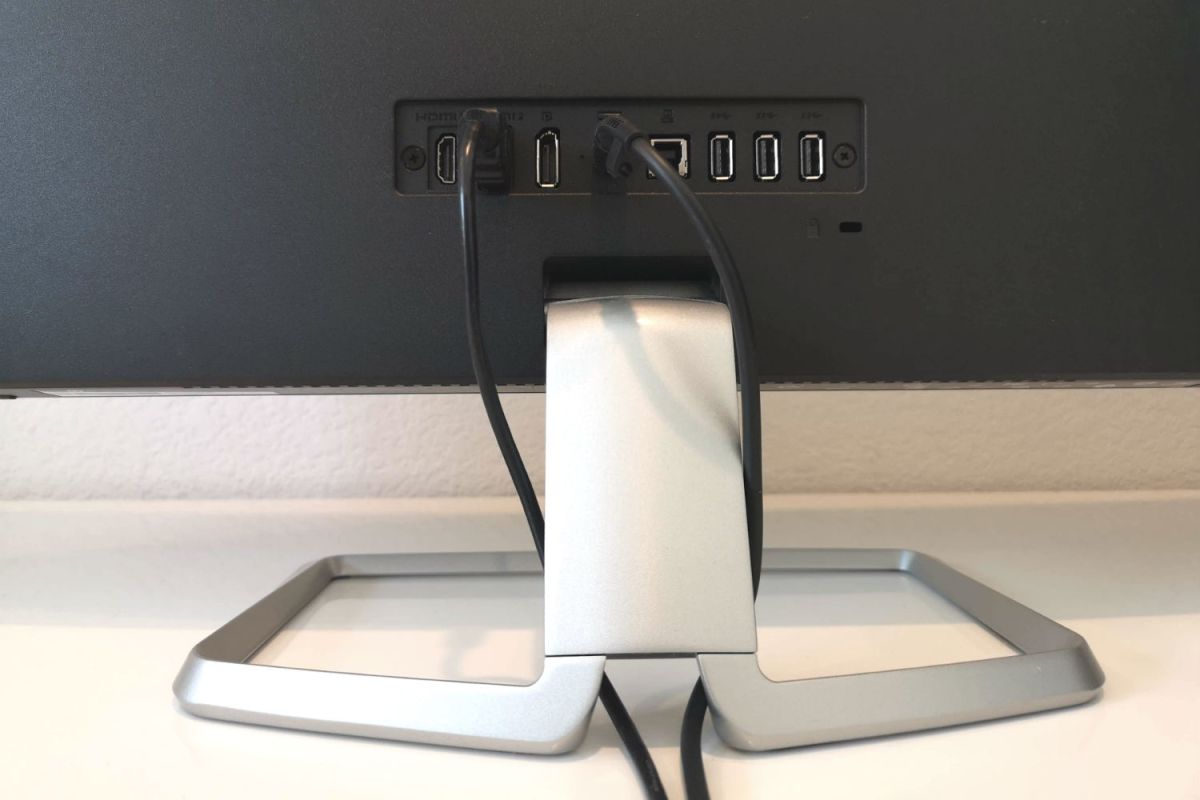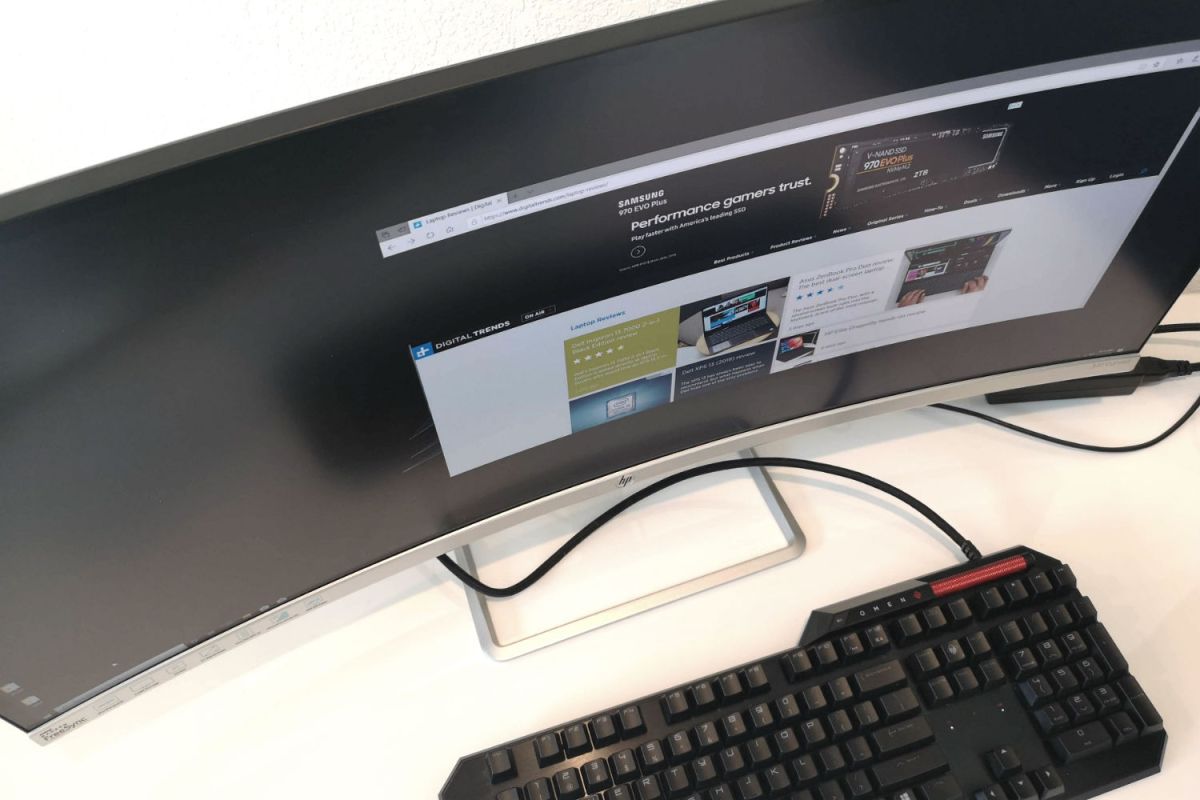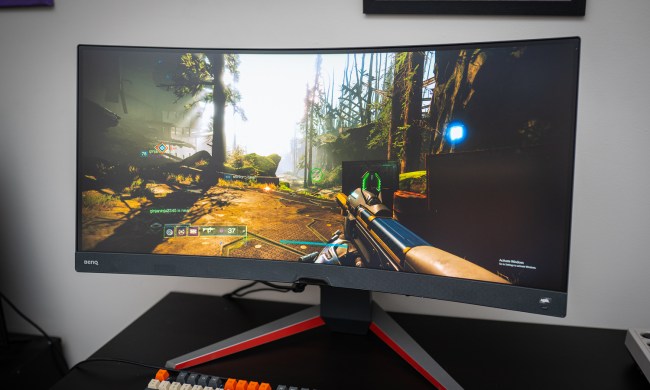- Support for wide color spaces
- Clean, modern design
- Excellent contrast with color accuracy
- Large, ultrawide and curved screen
- Affordably priced
- No built-in speakers
- Limited ergonomic adjustments
- No USB-C port
Among the sea of screens available today, HP’s 34f doesn’t ship with any boundary-pushing features that help it stand out. But don’t be so quick to dismiss it.
Priced modestly at $649 – you’ll be able to find the 34f at discounted prices – the HP 34f comes with accurate, punchy colors, though gamers will find its 60 Hz refresh rate a bit limiting. Still, with an ultra-wide 34-inch curved canvas and UWQHD resolution, the 34f is versatile enough to adeptly handle most home and office tasks. Additionally, this panel can also handle basic gaming with AMD FreeSync technology, and it’s ready for quick creative edits with support for wide color spaces.
When compared to similarly-sized offering, the value of HP’s 34f becomes clearer. Even though HP isn’t breaking any records with the 34f, this monitor is more than the sum of its parts, and it comes with features that most consumers will appreciate at an affordable price.
Minimal, but not basic
As a budget-friendly, mid-range monitor, HP kept the design of the 34f very simple, which helps lend this panel its minimalist aesthetics.
The silver accents combined with black on the rear gives the 34f a very elevated feel — from a distance, it can almost pass for a machined metal monitor — and the panel’s choice of hue makes it a great companion to aluminum-clad laptop designs, like HP’s Envy lineup or Apple’s MacBook Air.
A silver metal rectangular shaped ring forms the 34f’s base, and the ring design does a solid job of anchoring the entire setup to your desk, A short silver plastic mounting arm attaches to the base with a thumb screw for tool-less assembly, while the screen itself snaps into place.

Initially, I was a little concerned about the plastic mounting mechanism not being as strong as a metal mount, but once the whole setup was assembled, durability was a non-issue, even when tilting the display.
The IPS screen itself is flanked by very small bezels and comes with an antiglare coating, which helps reduce reflections when working under ambient office lighting.
The slim bezels gave the 34f a modern appeal on my desk. The screen has tiny bezels along the top and side edges, and a slightly larger bottom chin round out the front of the setup. And unlike the LG UltraFine 4K, the panel itself is rather slim, with the ports, USB hubs, and electronics housed in a slightly thicker cabinet behind the screen, making it a great fit for cramped quarters like dorm rooms.
Buttons that can press your buttons
Compared to bottom-facing ports on monitors like the Alienware 34 Curved display, the rear-oriented ports are easier to access and more convenient. You’ll find three USB-A 3.0 ports, a USB-B port that connects to your PC’s USB-A port and turns the monitor into a USB hub, along with a power port, two HDMI connectors, and one DisplayPort.
Unfortunately, USB-C is notably missing, so newer computers, like Apple’s MacBook Pro or even HP’s EliteBook laptops, will need a separate USB-C to HDMI adapter to connect. This rather glaring omission means that you won’t be able to rely on a single cable setup to connect a laptop to this panel for display output, USB hub connectivity, and power.

The slim screen on the HP 34f gives this monitor a supermodel-like profile unlike the chunky display on LG’s 24-inch UltraFine 4K. Still, where the 34f falls short compared to more expensive monitors is that the power supply isn’t built in, leaving you with a dangling power brick that you’ll need to conceal if you want a tidy desk setup that gets Marie Kondo’s nod. Surprisingly, given that it’s a monitor made for consumers, the 34f doesn’t come with any built-in speakers, so you’ll need to provide your own for multimedia playback.
A row of buttons line the bottom right edge of the panel used to turn the screen on and off as well as navigate the different menus. Though the buttons are responsive and easy to press, navigating between the different on-screen menu trees can be cumbersome and less intuitive than a single joystick, like on the rear of Dell’s new 2019 Alienware Curved 34 monitor or the AOPEN 32HC1.
The buttons allow you to make granular adjustments for the screen brightness and contrast, switch between display sources, or enter one of the pre-set modes optimized for reducing blue light emissions or for specific content like photos, videos, and games.
Going wide
With a spacious 34-inch canvas and a resolution of 3,440 x 1,440 pixels, using an ultrawide display like the HP 34f is like having a dual-monitor setup, giving you ample screen real estate to juggle between your browser windows, Word documents, Excel spreadsheets, and PDF files comfortably.
The subtle curvature of the 34f helps to keep you immersed in your content, and if you’ve never used an ultra-wide panel before, it’s a joy provided you have enough desk depth to take full advantage of the screen without feeling like your face is too close to the monitor.
If you value the productivity aspect of the ultrawide aspect ratio, having a single ultrawide panel delivers more convenience than setting up two FHD monitors side-by-side — you’re getting the full screen real estate without the cable clutter or the seam where the displays would otherwise connect.

HP rates the display the 34f at 300 nits of brightness, which is on par with the brightness of most Ultrabooks on the market today. Though it doesn’t peak at a retina-blinding 1,600 nits like Apple’s Pro Display XDR or Asus’ recent ProArt monitors, I had no problems with the brightness levels on the 34f with normal ambient lighting. Situated in a home office on a desk adjacent to a window with a fair amount of natural light shining through, I found that the 34f’s display to be best at around 60 percent brightness.
The panel’s Adobe RGB score falls behind more professional panels, like LG’s UltraFine 5K.
And even though this panel can’t compete against more color accurate panels, the HP 34f still holds its own ground for quick creative edits if you need to take projects home.
Our Datacolor display analysis taken with the SpyderX Elite calibration tool revealed that the 34f is capable of displaying 99 percent of the sRGB color space, 80 percent of the Adobe RGB color space, or 82 percent of the wide P3 color space. The former two scores placing this panel in the company of devices, like the MacBook Air, Dell Ultrasharp U3818, but the panel’s Adobe RGB score puts it approximately 10 points behind more professional panels, like LG’s UltraFine 5K.
The display’s color accuracy and uniformity are also rated well, with a Delta E score of just under 2 points. This makes the 34f more accurate than Samsung’s CF791 and places it on par with LG’s 34UC89G. For comparison, Apple’s 5K iMac’s display has a better 0.98 Delta E score. Uncalibrated out of the box, the 34f’s screen appeared slightly cooler with paler skin tones. Post-calibration, screen tones appeared slightly warmer, but overall, color reproduction in other areas remained consistent. Given the panel’s good color reproduction, this panel can serve in a pinch for video and photo editing for home users without access to a professional screen.

Contrast was similarly excellent on the 34f, with a ratio of 1020:1 at 100 percent brightness. In use, my only major complaint with this panel is with uniform screen brightness, with the screen being lit more brightly along with bottom left and right edges. For most tasks, you likely won’t even notice this, but the issue becomes more apparent when viewing content against a black background, like darker scenes in a movie or video game.
Given that the 34f tops out at 60Hz, serious gamers likely won’t want to consider the slower refresh rate on this panel. However, with built-in AMD FreeSync support, the panel is still a decent monitor for casual gaming.
The screen on this panel can tilt upward or downward, but it cannot be raised or lowered.
Most modern games played with lower game settings performed fine, though stuttering and screen tearing became noticeable on more demanding titles played at higher graphics settings. At 1080p or QHD resolution and low to medium settings, the monitor does a decent job.
Another quibble is that as ergonomic adjustments on the 34f is rather limited, but it’s a problem that’s fairly common on consumer monitors. Like the budget-oriented AOPEN 32HC1, and even HP’s Envy 34 Curved All-in-One desktop, the screen on this panel can tilt upward or downward, but it cannot be raised or lowered. Another limitation is that you can’t rotate the screen from landscape to portrait.
Our take
Multitaskers who find themselves running out of screen space should consider either a multi-monitor setup or a single ultrawide display. While connecting several monitors together can create clutter and leave you with seams where the panels join together, the latter solution can be a pricey alternative. Thankfully, if your needs are limited to basic office tasks and simple creative projects, HP’s 34f delivers an immersive experience thanks to its 34-inch curved ultra-wide QHD resolution at a more budget-friendly $649 price.
Is there a better alternative?
Lacking the bells and whistles of many of its competitors is what helps keep the HP 34f more modestly priced. For comparison, HP’s EliteOne 1000 34-inch curved comes with the same screen size and resolution in a curved form factor, but the panel comes with an extended three-year business-class warranty along with a pop-up webcam. Though the basic features are similar with the 34f, the EliteOne 1000 costs nearly $900 more.
Dell’s UltraSharp 34 Curved U3415W priced at $749 is a closer match to HP’s 34f. Like the EliteOne, this monitor shares the 34f’s screen size, curved experience, and screen resolution. However, the UltraSharp currently retails at a $100 premium, and the bottom-facing ports on this monitor makes it less convenient than on HP’s model. And while both Dell’s and HP’s 34f are cheaper than Samsung’s highly rated $799 ultrawide CF791, the latter covers 125 percent of the sRGB color space and ships with built-in speakers. Creatives who have the funds can step up to BenQ’s $900 ex3501r, which comes with a slightly 35-inch, color accurate HDR panel. This screen’s 100 Hz refresh rate makes it ideally suited for both creative tasks and gaming.
How long will it last?
The HP 34f comes with HP’s standard one-year warranty, making it on-par with other consumer displays in its class. This is shorter than the three-year standard warranty available on some premium gaming monitors or on professional displays, like HP’s Elite line. Given the panel’s relatively high UWQHD resolution, it should be relevant for at least a few years — or at least until higher UHD resolution in wider formats become the norm. You’ll may want to splurge and add an extended warranty if you intend on keeping the 34f on your desk for a while.
Should you buy it?
Yes, HP’s 34f is a monitor that comes with many features that will please most home user or office worker, and it delivers all this at a modest price.




